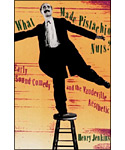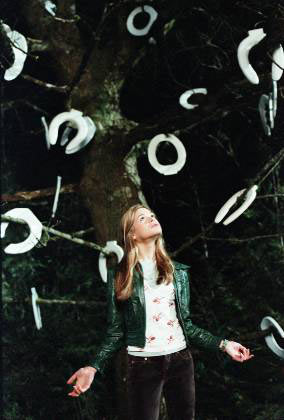I’ve been thinking about why I’m watching so much telly lately, and what it all means. Because, you see, I’ve not been a regular tv viewer for aaages – I’m simply too busy out dancing or doing other things in the evenings to watch telly (let’s not talk about daytime tv – I ignore it). But lately I’ve been catching up on my tv viewing with some dvd versions of telly programs. Now, I know that I’m not watching these programs as they were intended (ie once a week over 12 weeks or so), I’m bingeing, and this is changing the ways I think about these programs – as texts and narratives, but…
Well, look, it’s an interesting point, isn’t it? I read an interesting point on the Firefly fan site (yes, it’s sad – deride me. I deserve it) about the idea of ‘time’ in telly series. Someone noted that Whedon had to use 9 characters on Firefly and Angel because two or three simply can’t sustain interest and complexity over 12 weeks. You need more people because you can offer more story lines over a long period of time (what, 12 hours worth?). It’s kind of the soap opera rule, I guess. And that’s kind of a cereal thing.
So, ok, you’ve got 9 characters and 12 hours to use in developing a narrative.
With a film, you have 2 hours max. So 9 characters can get crowded (which is one of the justifications for [Serenity spoiler approaches] killing off Wash and Book in Serenity. One I’m not too sure I’m buying – Wash!).
So what happens when I watch 12 episodes of Dead Like Me in a row? Or 4 or 5 on one Sunday afternoon?
When I do these binges, I tend to feel a bit crowded inside. Lots of characters, lots of events, lots of stuff to absorb. I miss out on the slow assimilation of information. I don’t do the between-episode thinking and digesting. I kind of feel like I’m also not doing the adding-in part of viewing to the same extent. You know the way a program and characters live in your mind between viewings? The way you think about them, talk about them, read about them online, see parallels and homages to them in other programs… When you binge, you miss that stuff. So am I making these programs less interesting for myself?
Thing is, programs like Firefly and Twin Peaks and Buffy and Angel and Battlestar Galactica can handle being watched in binges – they’re interesting. Dumb shows with less going on, narrative-wise, character-wise, plot-wise, brain-wise (or discursively-wise) tend to get really tedious in big binges. You need to watch them weekly.
Now I’m thinking: does this explain why these shows get such hardcore fan bases?
And then I think ‘nah’. Because dumb shows like 90210 or Friends get hardcore fan bases. And I suspect that weekly screenings help – esp if you’re watching with friends. I think about queer readings of Friends: you add stuff in to make it interesting. So you view with a bent eye to add in interesting stuff. You do more work, watching, to make the two guys (whose names I can’t remember) who live together into a couple. Could you do this if you were bingeing? Would you have time – brain time – to re-read these doods as queer?
Hm. I’m not convinced. I think about the way I love chick flicks: I’m adding in stuff when I view, and I don’t need ‘more time’ to do it…
Well, either way, binge-viewing certainly changes my experience of the program. I do repeat viewings in different ways too – I binge, then I go back and revisit particular episodes to catch favourite moments, explore issues, etc. I rewatch the whole lot (another binge) to pick up the bits I missed the first time. I rewatch with friends for added pleasure. These extra bits don’t include the names of episodes – I can never remember them. I don’t much care, either: I tend to think of the seperate episodes as chapters in the whole story. So they could be ‘1’ or ‘3rd’.
All this is similar to the way I read books. Binge and then re-read.
I remember watching Twin Peaks weekly in a proper ‘fannish’ way. Lunchtime analysis and deconstruction. Scanning magazines for articles about characters/actors. Chasing down the director and actors’ past work. All this added to my weekly viewing.
With my binge viewing, I supplement my binges with online read-ups (though I’m not that keen for that stuff). We didn’t have access to that in 1990 (or whenever it was), so we made do with magazines.
The Squeeze goes to regular screenings of BSG with his BSG nerd mates. As one of them said in response to my ‘oh man, I couldn’t handle wasting a whole day watching telly – I’d rather be talking or playing games or eating or something’ , it’s not about the watching, really. It’s about the getting-together. You might be talking about BSG, you might be talking about uni or work or flirting or whatever. It’s the social interaction that’s important.
I’m not that keen on bingeing socially, though… hm. Well, I like watching with The Squeeze (though I’m just as happy watching alone)…
This reminds me of a point in my research where I was thinking about swing dancers as fans. While you can watch telly alone and never speak of your passion for Firefly with anyone else, you have to swing dance with other people. It’s absolutely, and inevitably and undeniably about social interaction. It’s also about physical, embodied social interaction with lots of physical contact and body-thinking and talking. Being a swing dancer is about community. Being a telly fan isn’t necessarily about sharing the experience. But it can help.
hm…
It’s all interesting.
And of course, all my supes’ fault: it was that paper she gave on teen telly. And possibly there’s some link to my crazy Firefly/DLM/BSG viewing….




